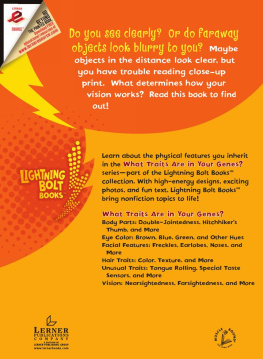Vision:
Nearsightedness,
Farsightedness,
and More
Jennifer Boothroyd
For Ava, who looks
fabulous in glasses
-J.B.
Copyright 2013 by Lerner Publishing Group, Inc.
All rights reserved. International copyright secured. No part of this book may be reproduced,
stored in a retrieval system, or transmitted in any form or by any meanselectronic, mechanical,
photocopying, recording, or otherwisewithout the prior written permission of Lerner Publishing
Group, Inc., except for the inclusion of brief quotations in an acknowledged review.
Lerner Publications Company
A division of Lerner Publishing Group, Inc.
241 First Avenue North
Minneapolis, MN 55401 U.S.A.
Website address: www.lernerbooks.com
Library of Congress Cataloging-in-Publication Data
Boothroyd, Jennifer, 1972
Vision : nearsightedness, farsightedness, and more / by Jennifer Boothroyd.
p. cm. (Lightning bolt booksWhat traits are in your genes?)
Includes index.
ISBN 9780761389408 (lib. bdg. : alk. paper)
1. VisionJuvenile literature. 2. Vision disordersJuvenile literature. I. Title.
QP475.7.B65 2013
612.8'4dc23 2011047643
Manufactured in the United States of America
1 CG 7/15/12
Table of Contents
Genes
Humans are the
same in many ways.
Humans have more in common
with one another than they
do with dogs and other animals.
But humans also have
differences. Thats how you
can tell one from another.
These team members dont all look alike.
These differences are
called traits.
Eye color, skin
color, and height are a few of
our many traits.
Brown eyes and blue eyes are both traits.
We get our traits from our
birth parents. Each parent
passes on instructions
for traits in their
genes.
Birth parents are related to their children. Adoptive parents take a child into their family and become his or her parents.
Genes have
information
about
how we
grow and
develop.
This scientist is studying genes. Genes are too small to see with just our eyes. Genes are inside us.
Vision
One thing that genes give
instructions for is vision.
A doctor tests this boys vision.
People see things that
are near them.
People
see things that are far away.
People
see many
different
colors.
Many genes
are responsible
for our sight.
Both of your parents gave you genes that control how you see.
Nearsightedness
Many people have trouble
seeing things far away.
Distant objects look blurry.
This girl has trouble seeing distant trees clearly.
But they easily
see things up close.
This is called
nearsightedness.
This boy sees close- up things the best. He doesnt see as well far away.
Nearsighted people see clearly with glasses.
Nearsighted people often wear
glasses to help them see far.
The lenses are curved to
help their eyes focus on
things farther away.
Some nearsighted people wear contacts. Contacts are curved just as glasses are.
Farsightedness
Many people have trouble
seeing things close up. Close
objects look blurry.
This man sees the newspaper more clearly when he holds it a little bit away from his face.
But they have no problem
seeing things far away.
This is called farsightedness.
This farsighted man can see faraway objects well.
Many kids learn they need glasses when they first start school. They find that they cant see clearly when they read and write.
Glasses can help farsighted
people see more clearly
close up.
The lenses are curved to help
their eyes focus on objects
close to their face.
This farsighted woman wears contacts instead of glasses to help her see close up.
Some people have trouble
seeing both near and far.








































